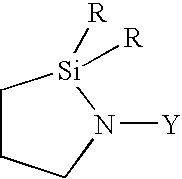Crosslinkable compositions based on organosilicon compounds
- Summary
- Abstract
- Description
- Claims
- Application Information
AI Technical Summary
Benefits of technology
Problems solved by technology
Method used
Image
Examples
example 1
[0083] 406 g of an α,ω-dihydroxypolydimethylsiloxane having a viscosity of 80,000 mPas, 182 g of a trimethylsilyl end-capped polydimethylsiloxane having a viscosity of 1000 mPas, and 1.6 g of 1,1-dimethyl-2-(3-aminopropyldimethylsilyl)-1-sila-2-azacyclopentane are mixed with one another in a planetary mixer and stirred for 60 minutes. Subsequently, 14 g of 3-(2-aminoethyl)aminopropyltriethoxysilane and 29.0 g of vinyltrimethoxysilane are added and the whole mixture is stirred for a further 15 minutes. Finally, the mixture is completed by homogeneously mixing in 1.1 g of octylphosphonic acid, 63 g of pyrogenic silica having a specific surface area of 150 m2 / g (commercially available under the HDK® V15 brand from Wacker-Chemie GmbH, Munich, Germany) and 0.8 g of a tin catalyst which is prepared by reacting 2.2 parts of di-n-butyltin diacetate and 4 parts of tetraethoxysilane. The thus obtained mixture is transferred into moisture-tight containers, and subsequently used to produce spec...
example 2
[0084] The procedure described in example 1 is repeated with the difference that instead of 1.6 g of 1,1-dimethyl-2-(3-aminopropyldimethylsilyl)-1-sila-2-azacyclopentane, 2.2 g of 1,1-dimethyl-2-(3-aminopropyldimethylsilyl)-1-sila-2-azacyclopentane are used. The results can be found in Table 1.
example 3
[0085] The procedure described in example 1 is repeated with the difference that instead of 1.6 g of 1,1-dimethyl-2-(3-aminopropyldimethylsilyl)-1-sila-2-azacyclopentane, 2.8 g of 1,1-dimethyl-2-(3-aminopropyldimethylsilyl)-1-sila-2-azacyclopentane are used. The results can be found in Table 1.
TABLE 1ExpulsionTensilerateShore AModulusstrengthElongation atExample[g / min]hardness[N / mm2][N / mm2]break [%]116.2170.311.1530220.4140.281.0580319.8110.220.7640
PUM
| Property | Measurement | Unit |
|---|---|---|
| Fraction | aaaaa | aaaaa |
| Percent by mass | aaaaa | aaaaa |
| Percent by mass | aaaaa | aaaaa |
Abstract
Description
Claims
Application Information
 Login to view more
Login to view more - R&D Engineer
- R&D Manager
- IP Professional
- Industry Leading Data Capabilities
- Powerful AI technology
- Patent DNA Extraction
Browse by: Latest US Patents, China's latest patents, Technical Efficacy Thesaurus, Application Domain, Technology Topic.
© 2024 PatSnap. All rights reserved.Legal|Privacy policy|Modern Slavery Act Transparency Statement|Sitemap



